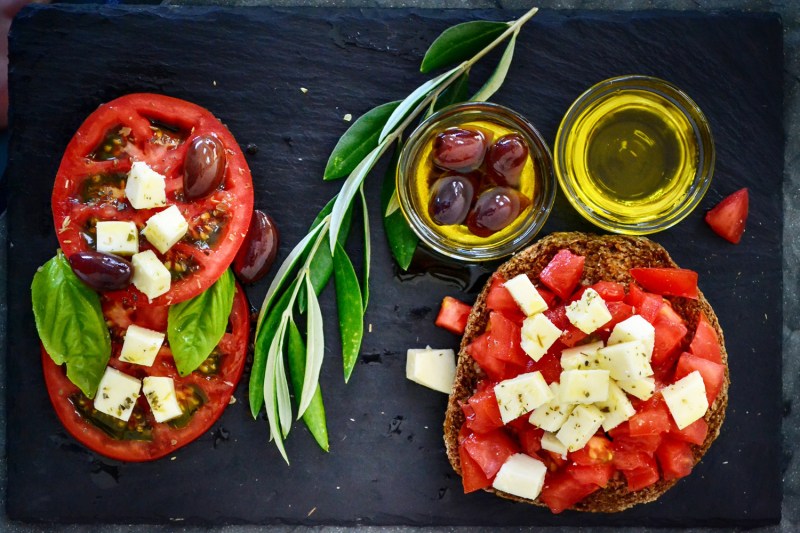With so many fad diets circulating social media, it can be hard to know which eating methods are actually good for you and sustainable. As a nutritionist, I have worked with numerous clients who were confused by conflicting information when it came to nutrition. Luckily, both the DASH diet and the Mediterranean diet are solid options when it comes to your health.
You know you want to eat better, but which should win in the DASH diet vs. Mediterranean diet debate? Keep reading to discover the one that is best for you!
What is the DASH diet, and who is it for?

The DASH diet—short for Dietary Approaches to Stop Hypertension—was designed specifically for those looking to lower their high blood pressure without using medication. It emphasizes reducing how much sodium you consume while increasing your intake of nutrient-rich foods like fruits, vegetables, whole grains, and low-fat dairy. Lean protein, nuts, and legumes are also encouraged, while processed foods, red meat, and added sugars should be limited.
This eating plan is structured and backed by decades of research. For example, this NIH study shares that “The results revealed that the DASH diet alone led to a significant reduction in blood pressure. However, when combined with sodium reduction, the blood pressure reduction was even greater.”
The DASH diet is fairly simple, as it focuses on portion control, balance, and hitting daily nutritional targets. Because of this, it’s especially beneficial for those who want to improve their heart health, reduce blood pressure, or manage weight in a sustainable way.
Although it was originally created for people with hypertension, the DASH diet can benefit nearly anyone. However, it may feel more rigid than other eating styles due to its specific guidelines and recommended servings from each food group.
What makes the Mediterranean diet so popular?

The Mediterranean diet is inspired by the traditional eating habits of countries bordering the Mediterranean Sea, like Greece and Italy. It’s known for being flexible, flavorful, and easy to maintain over the long term. Instead of strict rules, it promotes a general lifestyle built around wholesome, unprocessed foods.
This diet emphasizes olive oil, fruits, vegetables, whole grains, legumes, and nuts. Fish and seafood are eaten regularly, while red meat and sugary desserts are kept to a minimum. Moderate wine consumption is also common in Mediterranean cultures and is sometimes included as part of the lifestyle.
One of the biggest reasons for its popularity is the strong body of research supporting its health benefits. Studies show it can reduce the risk of heart disease, type 2 diabetes, and certain cancers. Because it’s more relaxed than other diets, many people find it easier to stick with it permanently rather than just for a few weeks.
Key differences between the DASH diet and the Mediterranean diet

While both diets promote whole foods and limit processed items, they differ in structure and focus. The DASH diet is more prescriptive. It recommends exact servings of food groups each day—like four to five servings of vegetables, two to three servings of dairy, and so on. It also has clear sodium limits, typically 1,500 to 2,300 mg per day.
The Mediterranean diet, on the other hand, doesn’t require tracking portions or calories. It encourages intuitive eating based on general food categories. Olive oil is a major source of fat, while the DASH diet prefers vegetable oils that are lower in saturated fat.
Dairy is another key difference: DASH includes low-fat dairy as a core component, while Mediterranean eating uses it sparingly. The DASH diet focuses more on lowering blood pressure, while the Mediterranean diet is broader in its heart-health and anti-inflammatory benefits.
Which eating method is best for you?

When deciding between the DASH and Mediterranean diets, consider your personal health goals, preferences, and habits. If you’re specifically trying to lower your blood pressure or manage your sodium intake, the DASH diet may be more appropriate due to its clinical approach and measurable targets.
However, if you’re looking for a more relaxed, enjoyable way to eat that supports overall health and long-term sustainability, the Mediterranean diet could be a better fit. It’s ideal for people who enjoy cooking, appreciate variety, and want to avoid the rigidity of meal plans or portion control.
Think about how much time and effort you’re willing to spend on meal prep and tracking. The DASH diet may require more planning upfront, especially to meet its nutrient targets. The Mediterranean diet, in contrast, can be adapted more easily to your current lifestyle.
Both are excellent choices, so don’t stress, as the right one likely comes down to which one you can stick to consistently.
Frequently asked questions

What is the healthiest diet in the world?
There’s no one-size-fits-all healthiest diet, but the Mediterranean diet is often ranked the best overall. It emphasizes whole foods like fruits, vegetables, fish, olive oil, and whole grains. Backed by decades of research, it supports heart health, longevity, and sustainable eating without being overly restrictive or hard to follow.
Is pasta allowed on the DASH diet?
Yes, pasta is allowed on the DASH diet, especially whole grain varieties, as the diet encourages whole grains as a source of fiber and nutrients. Portion control is key, and pairing pasta with vegetables, lean protein, and a light sauce helps keep meals balanced and aligned with DASH diet principles.
Who is the DASH diet not recommended for?
The DASH diet may not be ideal for individuals with very low blood pressure, certain kidney conditions, or sodium loss disorders, as it emphasizes low sodium intake. Those needing higher fat intake, like people on ketogenic diets, may also find DASH unsuitable. It is always recommended that you consult a healthcare provider before starting any diet.




